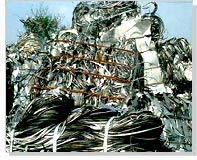Today, environmental considerations are at the forefront of material selection for specifiers. With its long service life, 100 % recyclability and valuable raw materials, stainless steel has become an excellent environmental performer. Products made of stainless steel rarely become waste at the useful end of their life. Recycled stainless steel objects are separated in a systematic manner and are recovered to go back into the manufacturing process through recycling.
As like iron, stainless steel contain valuable raw materials like nickel and chromium and that makes its recycling economically viable. The metal is economically recycled on a large scale across the world by recyclers who collect and process stainless steel scrap for remelting.
Scrap collection Stainless Steel Alloy Scrap The use of stainless steel scrap is fundamental to the process of steel making. The two basic types of scraps include -
Stainless Steel Alloy Scrap The use of stainless steel scrap is fundamental to the process of steel making. The two basic types of scraps include -
- Reclaimed scrap (old scrap) - It includes industrial equipment, tanks, washing machines and refrigerators, which have reached the end of their usage life.
- Industrial scrap (new scrap) - Industrial scrap includes production offcuts or industrial returns from manufacturing by industrial engineering and fabrication sources.
In present days, stainless steel is made up of approximately 60% recycled content, which include -
- 25% reclaimed scrap
- 35% industrial scrap
- 40% new raw materials
Due to the long service life of stainless steel products, the availability of scrap depends on the levels of production from decades ago. With an average 25% content of old scrap, the metal is close to the theoretical maximum content of material from end-of-life products.
Types / Grades of Stainless Steel ScrapDifferent grades and varieties of stainless steel scrap is used for recycling purposes and to recover pure metal from the scrap. Given in the table below are some of the important grades / types of stainless steel used in recycling.
Recycling the ScrapRecycling of stainless steel requires sophisticated technology and specialized expertise to separate and prepare each type of alloy for remelting. A recycling processor feeds the scrap into a large size shredder to break it into small size pieces. The scrap is then analyzed chemically and stored by type. The recycling process may include - blending the scrap into nickel alloys, chrome steels and other types of stainless steels. After blending into piles for particular customer requirements the scrap is then loaded into boxes for export to overseas mills.
ProcessStainless steel scrap along with other raw materials, such as ferrochromium (chrome/iron), nickel and ferro moly (molybdenum/iron) are blended into an electric furnace. After melting, the impurities are removed, the molten metal is refined and the chemistry is analyzed to ascertain what final adjustments are required for a particular type of stainless steel being manufactured. The molten metal is then casted into billets or slabs before final production of sheet, plate, coil, wire and other forms in formulation for use by industrial manufacturers.
Industrial manufacturers produce stainless steel items, which you see in your everyday products, including - cutlery, pots and pans, kitchen sinks and various industrial, architectural and other components. At every stage of the production and application process, the metal retains its basic characteristics and utility value. Unlike various industrial and engineering materials, stainless steel can be returned to its actual quality in the supply chain without any degradation.
Consumption of stainless steel scrap - 2004Given below are figures that reflect the consumption of stainless steel scrap by some important economies -
- China - 2.8 million tonnes of production using 900,000 tonnes of scrap.
- Japan - 2.4 million tonnes of production capacity using 900,000 tonnes of scrap.
- South Korea - 2.3 million tonnes of production using 800,000 tonnes of scrap.
- Product mix 80% austenitic, 20% ferritic.
- Taiwan - 2.6 million tonnes of production using 600,000 tonnes of scrap.
- India - 1.4 million tonnes of production using 300,000 tonnes of scrap.
